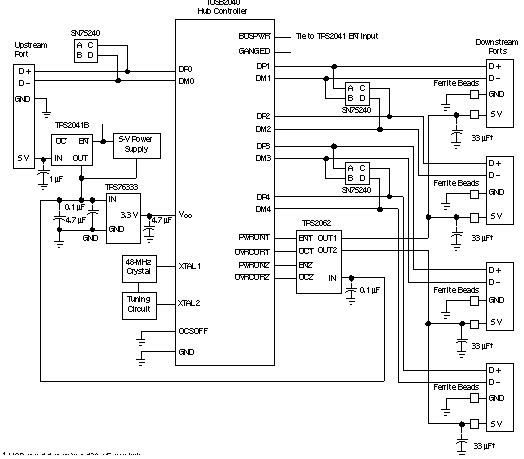SLVS490J december 2003 – august 2023 TPS2061 , TPS2062 , TPS2063 , TPS2065 , TPS2066 , TPS2067
PRODMIX
- 1
- 1 Features
- 2 Applications
- 3 Description
- 4 Revision History
- 5 Description (continued)
- 6 Pin Configuration and Functions
- 7 Specifications
- 8 Parameter Measurement Information
- 9 Detailed Description
-
10Application and Implementation
- 10.1
Application Information
- 10.1.1 Power-supply Considerations
- 10.1.2 OC Response
- 10.1.3 Power Dissipation and Junction Temperature
- 10.1.4 Thermal Protection
- 10.1.5 Undervoltage Lockout (UVLO)
- 10.1.6 Universal Serial Bus (USB) Applications
- 10.1.7 Host/Self-Powered and Bus-powered Hubs
- 10.1.8 Low-power Bus-powered and High-Power Bus-Powered Functions
- 10.1.9 USB Power-distribution Requirements
- 10.1.10 Generic Hot-Plug Applications
- 10.1
Application Information
- 11Device and Documentation Support
- 12Mechanical, Packaging, and Orderable Information
Package Options
Refer to the PDF data sheet for device specific package drawings
Mechanical Data (Package|Pins)
- D|8
- DGN|8
Thermal pad, mechanical data (Package|Pins)
- DGN|8
Orderable Information
10.1.9 USB Power-distribution Requirements
USB can be implemented in several ways, and, regardless of the type of USB device being developed, several power-distribution features must be implemented.
- Hosts/SPHs must:
- Current-limit downstream ports
- Report overcurrent conditions on USB VBUS
- BPHs must:
- Enable/disable power to downstream ports
- Power up at <100 mA
- Limit inrush current (<44 Ω and 10 μF)
- Functions must:
- Limit inrush currents
- Power up at <100 mA
The feature set of the TPS206x allows them to meet each of these requirements. The integrated current-limiting and overcurrent reporting is required by hosts and self-powered hubs. The logic-level enable and controlled rise times meet the need of both input and output ports on bus-powered hubs, as well as the input ports for bus-powered functions (see Figure 10-5).
 Figure 10-5 Hybrid Self / Bus-Powered Hub Implementation
Figure 10-5 Hybrid Self / Bus-Powered Hub Implementation